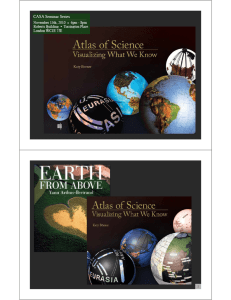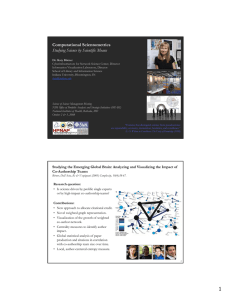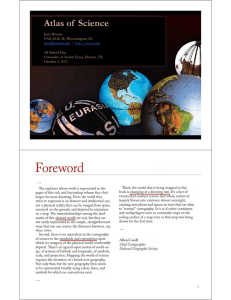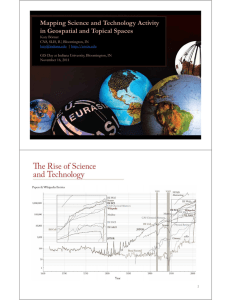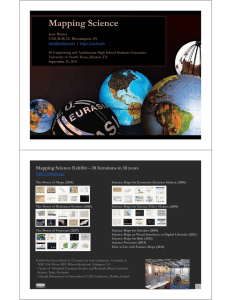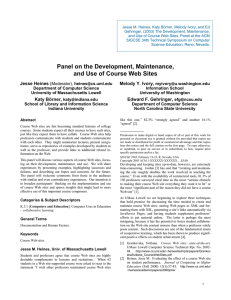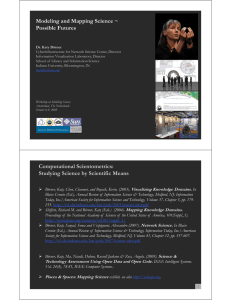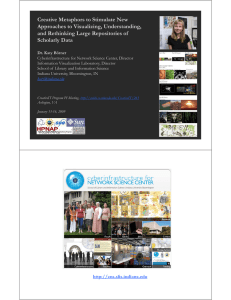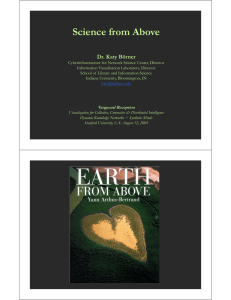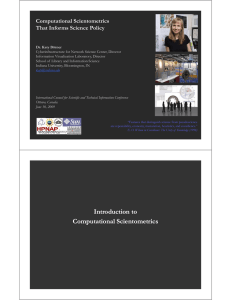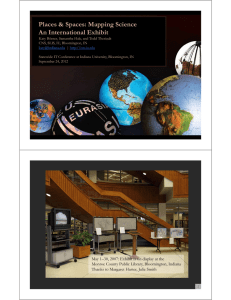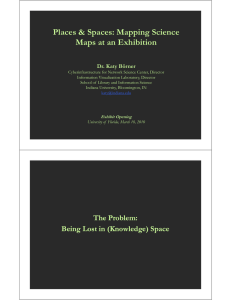Science from Above Dr Katy Börner Dr. Katy Börner
advertisement
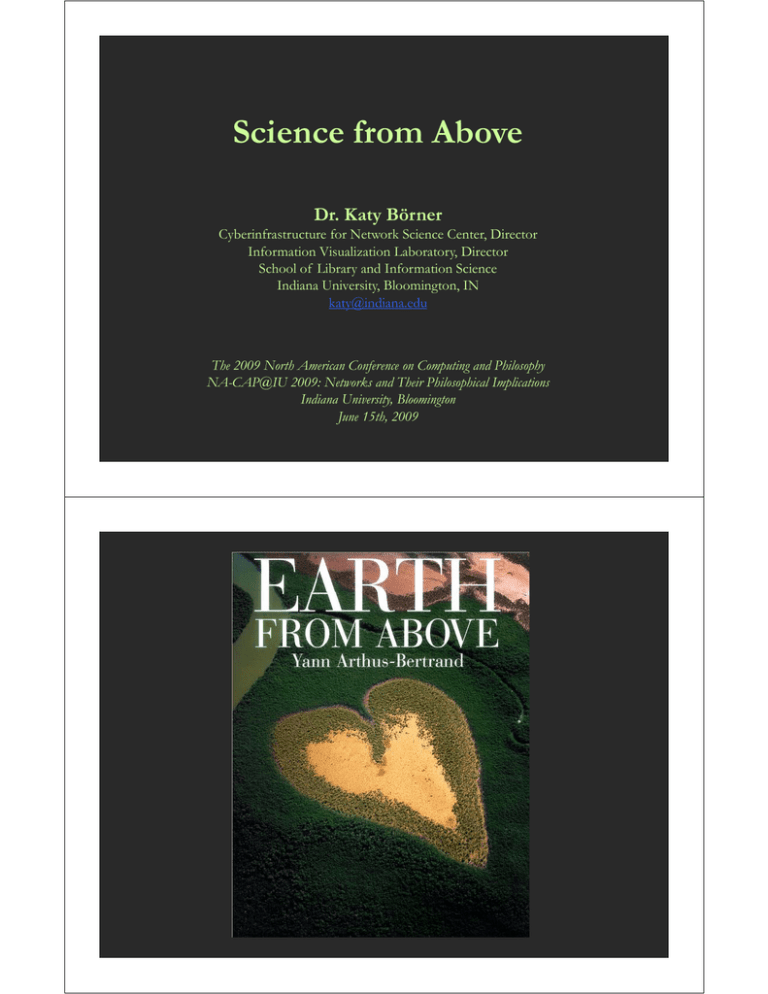
Science from Above Dr Katy Börner Dr. Cyberinfrastructure for Network Science Center, Director Information Visualization Laboratory, Director School of Library and Information Science Indiana University, Bloomington, IN katy@indiana.edu The 2009 North American Conference on Computing and Philosophy NA-CAP@IU 2009: Networks and Their Philosophical Implications Indiana University University, Bloomington June 15th, 2009 Cartographic maps of physical places have guided mankind’s explorations for centuries. They enabled the discovery of new worlds while also marking territories inhabited byy the unknown. Without maps, we would be lost. 3 Domain maps of abstract semantic spaces aim to serve today’s today s explorers navigating the world of science. science These maps are generated through a scientific analysis of large--scale scholarly datasets in an effort to connect and make large sense of the bits and pieces of knowledge they contain. Th can be They b used d to t identify id tif objectively bj ti l major j research h areas, experts, institutions, collections, grants, papers, journals, and ideas in a domain of interest. Science maps can provide overviews of “all“all all-of of--science” science or of a specific area. They can show homogeneity vs. heterogeneity, cause and effect and relative speed effect, speed. They allow us to track the emergence, evolution, and disappearance of topics and help to identify the most promising areas of research. 6 Places & Spaces: Mapping Science a science exhibit that introduces people to maps of sciences, their makers k andd users. Exhibit Curators: Dr. Katy Börner & Elisha Hardy http://scimaps.org 7 Mapping Science Exhibit – 10 Iterations in 10 years http://scimaps.org/ The Power of Maps (2005) Science Maps for Economic Decision Makers (2008) The Power of Reference Systems (2006) Science Maps for Science Policy Makers (2009) Science Maps for Scholars (2010) Science Maps as Visual Interfaces to Digital Libraries (2011) Science Maps for Kids (2012) Science Forecasts (2013) The Power of Forecasts (2007) How to Lie with Science Maps (2014) Exhibit has been shown in 52 venues on four continents. Also at - NSF, 10th Floor, 4201 Wilson Boulevard, Arlington, VA. - Chinese Academy of Sciences, China, May 17-Nov. 15, 2008. - University of Alberta, Edmonton, Canada, Nov 10-Jan 31, 2009 - Center of Advanced European Studies and Research, Bonn, Germany, Dec. 11-19, 2008. 8 Debut D b off 5th Iteration I i off Mapping M i SScience i E Exhibit hibi at MEDIA X was on M May 18 18, 2009 at W Wallenberg ll b H Hall, ll Stanford University, http://mediax.stanford.edu, http://scaleindependentthought.typepad.com/photos/scimaps 9 Authors are mortal. Papers are immortal. Monsters = ‘the unknown’ or voids. Impact of funding on science (yellow). Good and bad years. Hypothetical Model of the Evolution of Science - Daniel Zeller - 2007 10 Atlas of Science - Katy Borner - 2010 11 Science as accumulation of knowledge. d “Scholarly brick laying”. Standing on the shoulders of giants. Densely l knit k i communities. ii The importance of weak links. Hypothetical Model of the Evolution of Science - Daniel Zeller - 2007 Maps of Science: Forecasting Large Trends in Science - Richard Klavans, Kevin Boyack - 2007 13 In Terms of Geography - Andre Skupin - 2005 14 Areas of science are tube shaped. shaped Hypothetical Model of the Evolution of Science - Daniel Zeller - 2007 15 Atlas of Science - Katy Borner - 2010 16 HistCiteTM Visualization of DNA Development - Eugene Garfield, Elisha Hardy, Katy Borner, Ludmila Pollock, Jan Witkowski- 2006 17 114 Years of Physical Review - Bruce W. Herr II, Russell Duhon, Katy Borner, Elisha Hardy, Shashikant Penumarthy - 2007 18 Crust of science can represent “funding” or “usage”. Hypothetical Model of the Evolution of Science - Daniel Zeller - 2007 19 A Clickstream Map of Science – Bollen, Johan, Herbert Van de Sompel, Aric Hagberg, Luis M.A. Bettencourt, Ryan Chute, Marko A. Rodriquez, Lyudmila Balakireva - 2008 20 This drawing attempts to shows the “structure” of science. Many are interested to understand the “dynamics” dynamics of science. science Hypothetical Model of the Evolution of Science - Daniel Zeller - 2007 21 Council for Chemical Research - Chemical R&D Powers the U.S. Innovation Engine. Washington, DC. Courtesy of the Council for Chemical Research - 2009 22 Illuminated Diagram Display W. Bradford Paley, Kevin W. Boyack, Richard Kalvans, and Katy Börner (2007) Mapping, Illuminating, and Interacting with Science. SIGGRAPH 2007. Questions: • Who is doingg research on what topic and where? • What is the ‘footprint’ of interdisciplinary research fields? • What impact have scientists? Contributions: g resolution • Interactive, high interface to access and make sense of data about scholarly activity. Large-scale, high resolution prints illuminated via projector or screen. Interactive touch panel. 23 Science Maps in “Expedition Expedition Zukunft” Zukunft science train visiting 62 cities in 7 months 12 coaches, 300 m long Opening was on April 23rd, 2009 by German Chancellor Merkel http://www.expedition-zukunft.de 24 Thi is This i the th only l mockup k in i this thi slide lid show. h E Everything hi else l iis available il bl today. d Katy Borner: Computational Scientometrics That Informs Science Policy Contact the map makers via the exhibit curators: K Börner Katy B ((k (katy@indiana.edu k @ d katy@indiana.edu) d ) andd El Elisha h Hardy H d (efhardy@indiana.edu efhardy@indiana.edu)) 25 Computational Scientometrics: S d i S Studying Science i b by S Scientific i ifi M Means Börner, Katy, Chen, Chaomei, and Boyack, Kevin. (2003). Visualizing Knowledge Domains. In Blaise Cronin (Ed.), Annual Review of Information Science & Technology, Medford, NJ: Information T d IInc./American Today, /A i SSociety i ffor IInformation f i SScience i andd T Technology, h l V Volume l 337, Chapter Ch 5, 5 pp. 1791 9 255. http://ivl.slis.indiana.edu/km/pub/2003-borner-arist.pdf Shiffrin, Richard M. and Börner, Katy (Eds.) (2004). Mapping Knowledge Domains. Proceedings g off the National Academyy off Sciences off the United States off America,, 101(Suppl ( pp _1).) http://www.pnas.org/content/vol101/suppl_1/ Börner, Katy, Sanyal, Soma and Vespignani, Alessandro (2007). Network Science. In Blaise Cronin (Ed.), Annual Review of Information Science & Technology, Information Today, Inc./American S i t ffor Information Society I f ti Science Si andd Technology, T h l Medford, M df d NJ, NJ Volume Vl 41, 41 Chapter Ch pt 12, 12 pp. pp 537-607. 537 607 http://ivl.slis.indiana.edu/km/pub/2007-borner-arist.pdf Börner, Katy & Scharnhorst, Andrea. (2009). Visual Conceptualizations and Models of Science. JJournal off Informetrics. f Vol. 3(3), ( ) Elsevier. http://ivl.slis.indiana.edu/km/pub/2009p p borner-scharnhorst-joi-sos-intro.pdf Places & Spaces: Mapping Science exhibit, see also http://scimaps.org. 27 Cyberinfrastructures for a Science of Science Scholarly Database of 23 million scholarly records http://sdb.slis.indiana.edu Information Visualization Cyberinfrastructure http://iv.slis.indiana.edu Network Workbench Tool and Community Wiki *NEW* Scientometrics plugins http://nwb.slis.indiana.edu Epidemics Cyberinfrastructure http://epic.slis.indiana.edu/ 28 http://sci.slis.indiana.edu 29 Papers, maps, cyberinfrastructures, talks, press are linked from http://cns.slis.indiana.edu 30 The End.
